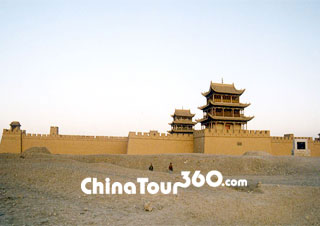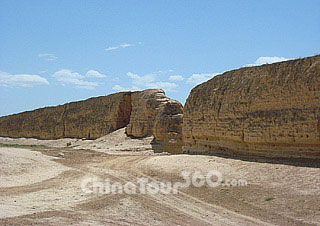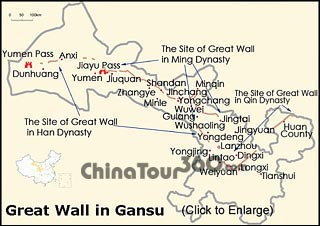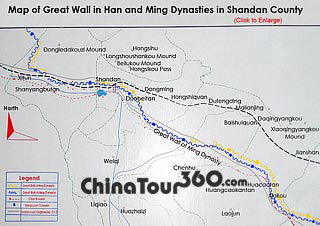 Jiayuguan Pass
Jiayuguan Pass Earth Wall in Shandan
Earth Wall in Shandan Wall of the Han Dynasty
Wall of the Han Dynasty Yumenguan Pass, Dunhuang
Yumenguan Pass, Dunhuang
Gansu Great Wall:
Yumenguan Yangguan Jiayuguan
Dunhuang Han Great Wall Overhanging
As a natural defense preventing the constant invasion of the northern tribes, Gansu province was of great military importance in ancient times. According to the archeological finds, the walls in the province were mainly built in the Warring States Period (476 BC - 221 BC), the Qin Dynasty (221 BC - 207 BC), the Han Dynasty (206 BC - 220 AD), and the Ming Dynasty (1368 - 1644).
In 275 BC, the Qin State of the Warring States Period built a wall to defend against the Hu tribe. Started from Linzhao County in Gansu, it stretched for 640 km (398 miles) all the way to the east and ended in Wuqi County, Shaanxi Province. The Qin Dynasty Great Wall is comprised of three parts: wall, beacon towers, and fortresses, and was built of earth. Though 2,000 years have passed, the walls of the Qin Dynasty, such as the sections in Linzhao, Weiyuan, and Longxi, can still be found. The Han Dynasty wall in the province traversed 16 cities and counties, including Dunhuang, Anxi, Yumen, Jiuquan, Zhangye, Shandan, and Wuwei, totaling 2,200 km (1,367 miles). Most parts were destroyed, only the parts in Dunhuang and Yanju are relatively well-preserved. The Ming Dynasty walls totals 1,400 km (870 miles). The most famous section is the Jiayuguan Pass, which is also the western starting point of the walls of the Ming Dynasty. As was true of the Han Dynasty Great Wall, they were also built of earth and comprised of walls, beacon towers, fortresses, and passes.
|
|
Most people think of high and substantial walls, castles or passes built on the steep ridges when talking about the Great Wall. However, due to the terrain and the various historical periods, the sections in Gansu are very different from others. For example, the western sections of the Qin Wall which went along the Yellow River were not solid walls. Because the Yellow River served as a natural barrier, no wall or moat was necessary, instead, forty-four towns were built at key points to prevent the Huns from passing the river. The garrison towns and the river combined together functioned as a defensive barrier in that region.
In the western part of Gansu, the moats formed the main fortification, with beacon towers built along it at intervals. Most remnants of the Han Dynasty wall found in Dunhuang, Yumenguan and Yangguan are fine examples. The best-preserved part the Ming Dynasty is the Jiayuguan Pass, a fort of strategic significance in the Hexi Corridor, part of the Northern Silk Road. A castle, with the imposing walls eleven meters (36 feet) high and 7,333 meters (8,019 yards) in perimeter, formed the westernmost extreme of the wall during the Ming Dynasty. Seven kilometers (4 miles) northwest of Jiayuguan, there is a narrow barrier built along a steep ridge, known as the Overhanging Great Wall.
Gansu Great Wall Photos: Jiayuguan, Dunhuang Great Wall, Shandan, Xiakou Ancient Town









